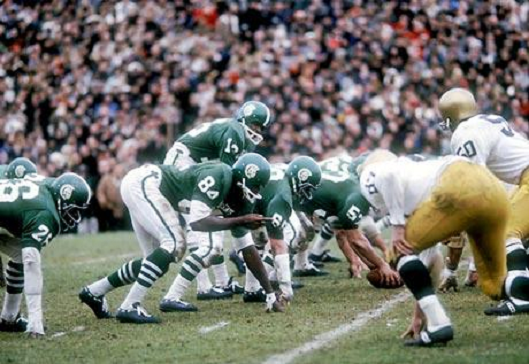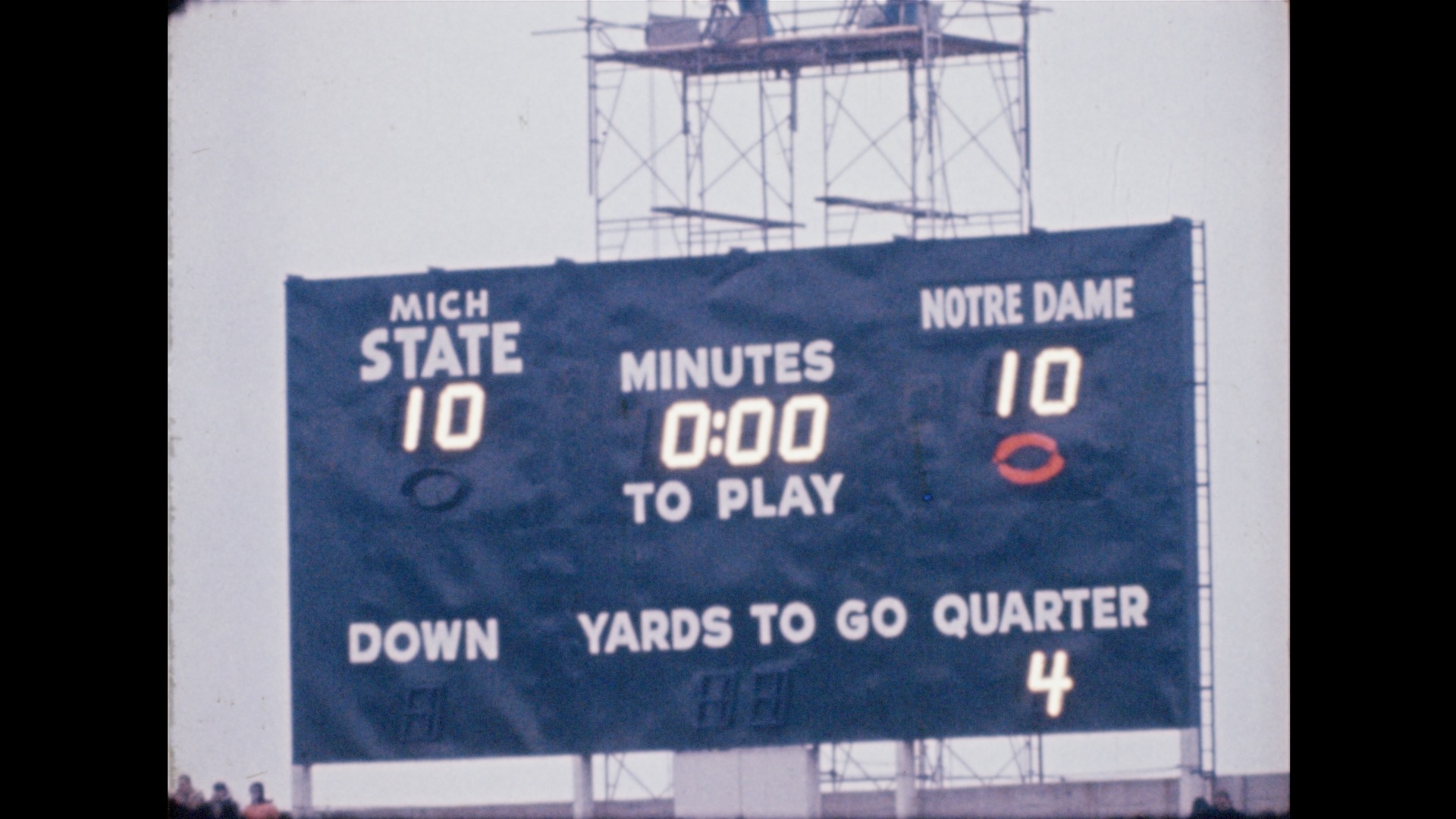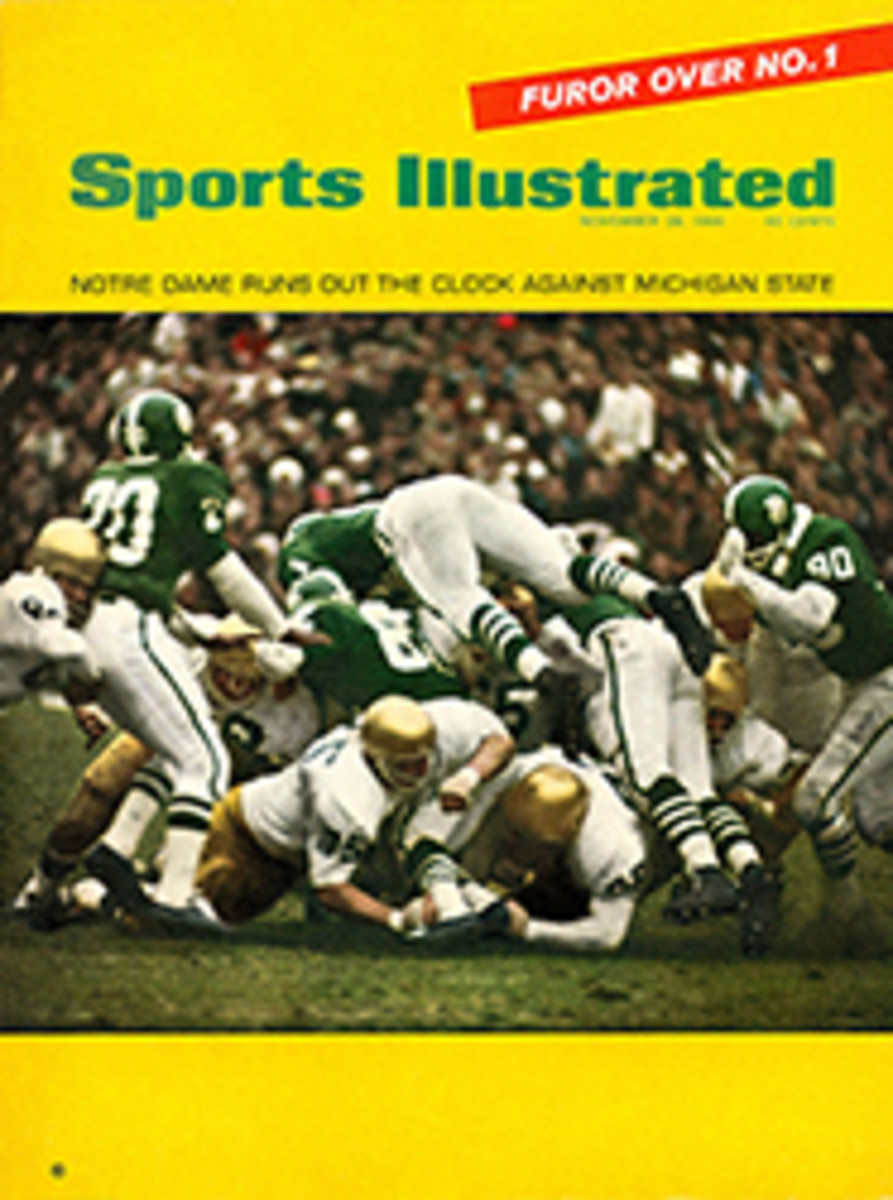Ara Parseghian (left) and Duffy Daugherty
November 19, 1966, 50 years ago: One of college football's occasional "Games of the Century" is played, at Spartan Stadium in East Lansing, Michigan.
Michigan State University, coached by Hugh "Duffy" Daugherty and known as "Duffy's Toughies," defending National Champions and now back-to-back Big Ten Champions, were undefeated, and ranked Number 1 in one of the major polls in use at the time and Number 2 in the other.
The University of Notre Dame, based in South Bend, Indiana, coached by Ara Parseghian, was also undefeated, and ranked 1st in one and 2nd in the other.
ABC televised the game nationally, albeit on a tape delay, with Chris Schenkel and former Oklahoma coach Bud Wilkinson calling it. This was the 1st time a single college football game went coast-to-coast over national television -- and in color, no less -- except for New Year's Day bowl games.
This was a time when the words "in color" and "coast-to-coast" still had a special meaning. Even today, ABC/ESPN and CBS split some of their games regionally: While the East Coast and the Midwest might see, for example, Ohio State vs. Penn State, the South and the West Coast might see, say, Southern California vs. Texas. But each network usually staggers its schedule so that, on any given Saturday, there's at least one game that most of the country, unless their own team is otherwise occupied, will want to see. In 1966, such a thing was still a novelty.
These two teams weren't even supposed to play. Notre Dame had usually played the University of Iowa on the 3rd Saturday in November from 1945 onward. But after 1964, Iowa opted out of that arrangement. Since Michigan State only had 9 regular-season games scheduled, and it was a relatively short trip -- 149 miles, or 2 1/2 hours by road -- the game was set up, and as luck would have it, they both came in undefeated, Number 1 vs. Number 2.
This was a time when the words "in color" and "coast-to-coast" still had a special meaning. Even today, ABC/ESPN and CBS split some of their games regionally: While the East Coast and the Midwest might see, for example, Ohio State vs. Penn State, the South and the West Coast might see, say, Southern California vs. Texas. But each network usually staggers its schedule so that, on any given Saturday, there's at least one game that most of the country, unless their own team is otherwise occupied, will want to see. In 1966, such a thing was still a novelty.
These two teams weren't even supposed to play. Notre Dame had usually played the University of Iowa on the 3rd Saturday in November from 1945 onward. But after 1964, Iowa opted out of that arrangement. Since Michigan State only had 9 regular-season games scheduled, and it was a relatively short trip -- 149 miles, or 2 1/2 hours by road -- the game was set up, and as luck would have it, they both came in undefeated, Number 1 vs. Number 2.
The teams had first played each other in 1897, before either one was a major football power. At this point, they had played each other every year since 1948.
Michigan State had gone to the Rose Bowl the year before. At the time, the Big Ten Conference had 2 unbelievably stupid rules: No team could go to the Rose Bowl in back-to-back years, and only the Conference Champion (or, if disqualified by the preceding stupid rule, the 2nd-place team) could go to any bowl game. This meant that, regardless of the result of their game against Notre Dame, MSU were not going to play a bowl game. (Purdue, quarterbacked by future Miami Dolphin Super Bowl winner Bob Griese, finished 2nd, and went on to their 1st-ever Rose Bowl, and won it for what remains the only time in their history.)
Notre Dame had a policy against bowl games, and hadn't been to one since Knute Rockne's legendary "Four Horsemen" (Harry Stuhldreher, Jim Crowley, Don Miller & Elmer Layden) beat Ernie Nevers' Stanford in the Rose Bowl on New Year's Day 1925. They wouldn't stop turning down bowl invitations until the 1970 season. So for both the Spartans and the Fighting Irish, this was it.
At first, it didn't go too well for Notre Dame: Their leading rusher, Nick Eddy, did not play due to a shoulder injury. Quarterback Terry Hanratty got sacked by the massive (for the time, anyway) Spartan defensive lineman (and future actor) Charles "Bubba" Smith, and had to leave the game with an injury. Center George Goeddeke hurt his ankle blocking for a punt.
Early in the 2nd quarter, the Spartans took a 7-0 lead on a Regis Cavender touchdown. God only knows what Regis Philbin, at age 32 already a known entertainer, and a Notre Dame graduate, so much of a fan that his request to be buried in the school's Cedar Grove Cemetery was granted, thought of a man named Regis scoring against his beloved Irish.
Dick Kenney, a barefooted kicker, added a field goal to make it 10-0 Michigan State. Barefoot kickers are now illegal in high school in every State except Massachusetts and Texas. It's still legal in college and in the NFL, but very rare since the 1980s.
Notre Dame came back. Backup quarterback Coley O'Brien threw a touchdown pass to Bob Gladieux, and it was 10-7 Spartans at the half. On the 1st play of the 4th quarter, Joe Azzaro kicked a field goal to tie it. There was still plenty of time left for either team to win the game.
A Spartan pass play gave both teams a good chance to score: Quarterback Jimmy Raye -- a black quarterback, not the first at Michigan State but rare on national television at that point -- attempted to pass to Gene Washington (not the man who went on to All-Pro honors with the 49ers and then became an executive in the NFL's main office; this one went on to play for the Vikings and Broncos), but Washington outran the pass, doubled back, and Tom Schoen intercepted it. That gave the Irish a chance, but Azzaro just missed what could have been a game-winning field goal.
The last series of the game began with 1:10 left on the clock, and Notre Dame had the ball on its own 30-yard line. Gaining 40 yards in 70 seconds would have put them in position for Azzaro to try again to win it with a field goal.
But Parseghian chose to run out the clock. He called 4 running plays, one of which gained a 1st down, then O'Brien was sacked by Bubba Smith, and then ran up the middle on the final play. None of these plays got the ball across midfield, let alone within field goal range. Final score, Michigan State 10, Notre Dame 10. The home crowd booed the final play-call.
I've seen ESPN Classic's broadcast of the game's surviving footage, which is all but the 1st quarter. The video is clear, the color is bright, and both teams, while looking small compared to the college teams of today, fought hard, and both seemed worthy of the National Championship -- until the last 70 seconds, of course.
Normally, the national media, so swept up in the myth of the Golden Dome -- Knute Rockne, George Gipp and Rockne's "Win One for the Gipper" speech, the Four Horsemen, Frank Leahy and "Leahy's Lads," and Paul Hornung... and this was well before Rudy Ruettiger and his movie, Joe Montana, and Lou Holtz's tenure -- gives Notre Dame the benefit of the doubt.
Not this time. In Sports Illustrated's writeup of the game, Dan Jenkins, until his death in 2019 perhaps the greatest living writer on the subject of college football, titled his article "Tying One for the Gipper." Jenkins quoted one observer as saying, "Parseghian had no guts."
Was that fair? Here was Ara's explanation: "We'd fought hard to come back and tie it up. After all that, I didn't want to risk giving it to them cheap. They get reckless and it could cost them the game. I wasn't going to do a jackass thing like that at this point."
Both teams ended the season 9-0-1. And the polls? Both the Associated Press (the college football writers) and United Press International (the coaches), still issuing their final polls before the bowl games, ranked Notre Dame Number 1 in their last poll, Michigan State Number 2, and undefeated Alabama Number 3.
Alabama, led by Paul "Bear" Bryant and actually having a bowl game to win, did so, beating Number 6 Nebraska in the Sugar Bowl, and finishing 11-0. They should have thus gotten their 3rd straight National Championship, having split the 1965 polls with Michigan State.
Both Notre Dame and Alabama claim to be 1966 National Champions, but Notre Dame still gets the official recognition. Keith Dunnavant came out with a book about the '66 Crimson Tide squad and how they were screwed by the polls, titling it The Missing Ring.
Ara Parseghian won another National Championship at Notre Dame in 1973, this time beating Alabama in a Number 1 vs. Number 2 matchup in the Sugar Bowl. That year, Ohio State and Michigan played to a tie, thus tying for the Big Ten title, and the Conference sent Ohio State to the Rose Bowl. Despite this, Ohio State coach Woody Hayes joined with Bo Schembechler, once his player and assistant coach but now the Michigan coach, in his outrage, and together they got the only-the-Rose-Bowl rule changed.
Ara Parseghian won another National Championship at Notre Dame in 1973, this time beating Alabama in a Number 1 vs. Number 2 matchup in the Sugar Bowl. That year, Ohio State and Michigan played to a tie, thus tying for the Big Ten title, and the Conference sent Ohio State to the Rose Bowl. Despite this, Ohio State coach Woody Hayes joined with Bo Schembechler, once his player and assistant coach but now the Michigan coach, in his outrage, and together they got the only-the-Rose-Bowl rule changed.
Duffy Daugherty remained Michigan State's coach until 1972, and lived until 19867, barely seeing the 20th Anniversary of this game. Parseghian retired after the 1974 season, and became a broadcaster in the sport. He died on August 2, 2017, at the age of 94. living long enough to see the 50th Anniversary of this game. He never took his good health for granted, and continued to raise money for research into diseases that have hit his family. Until the Kardashians became famous, he was easily the most famous American of Armenian descent. A statue of him stands outside Notre Dame Stadium.
Yet, even in death, he still gets dogged by charges of cowardice for 1966.
I'm not a Notre Dame fan. Indeed, I once did a blog post of "The Top 10 Reasons to Hate Notre Dame." Ara's successor, Dan Devine, who led them to the 1977 National Championship with Joe Montana at quarterback, once said, "There's Notre Dame fans, and then there's Notre Dame haters, and, frankly, they're both a pain in the ass."
But I think we can let Ara off the hook. Like Schembechler, Ara both played for Hayes and coached under him at Miami University of Ohio before becoming a great head coach himself. Woody's philosophy was simple: Run the football. Or, as it became known, "Three yards and a cloud of dust." I'm not sure if Woody came up with those words himself, but words that have been attributed to him are, "There are three things that can happen when you throw the football, and two of them are bad." In other words, an incomplete pass and an interception.
When Ara had 70 seconds of play remaining, and 70 yards to go for a touchdown, and at least 40 yards to go for a field goal, no doubt he heard Woody's wisdom in his mind. After all, at the time, the man was still, along with Bear Bryant at Alabama, recognized as one of the top 2 coaches in college football, well ahead of some men who would soon be adding to their records: Darrell Royal at Texas, John McKay at USC, and Joe Paterno, then in his 1st season at Penn State.
I'm not a Notre Dame fan. Indeed, I once did a blog post of "The Top 10 Reasons to Hate Notre Dame." Ara's successor, Dan Devine, who led them to the 1977 National Championship with Joe Montana at quarterback, once said, "There's Notre Dame fans, and then there's Notre Dame haters, and, frankly, they're both a pain in the ass."
But I think we can let Ara off the hook. Like Schembechler, Ara both played for Hayes and coached under him at Miami University of Ohio before becoming a great head coach himself. Woody's philosophy was simple: Run the football. Or, as it became known, "Three yards and a cloud of dust." I'm not sure if Woody came up with those words himself, but words that have been attributed to him are, "There are three things that can happen when you throw the football, and two of them are bad." In other words, an incomplete pass and an interception.
When Ara had 70 seconds of play remaining, and 70 yards to go for a touchdown, and at least 40 yards to go for a field goal, no doubt he heard Woody's wisdom in his mind. After all, at the time, the man was still, along with Bear Bryant at Alabama, recognized as one of the top 2 coaches in college football, well ahead of some men who would soon be adding to their records: Darrell Royal at Texas, John McKay at USC, and Joe Paterno, then in his 1st season at Penn State.
At the time, Woody and the Bear were it. Ara wanted to be "it," and, to do that, he couldn't lose this game. So he chose to not risk losing on an interception that might put Michigan State in position to win with a last-second field goal. It worked, and, as times changed, Ara became part of that top tier of great college football coaches.
In 1946, Army was undefeated and ranked Number 1, and Notre Dame was undefeated and ranked Number 2, and they finished the regular season against each other, at the original Yankee Stadium, in the 1st college football game to get the "Game of the Century" tag from the national media.
That game did not live up to the hype, ending in a 0-0 tie. As they would say in that other kind of football, soccer, "a turgid nil-nil draw." The word "turgid" so perfectly suits 0-0 draws, regardless of what game you call "football."
Frank Leahy, Notre Dame's coach at the time, had "tied one for the Gipper" 20 years before Ara. Yet he never got the derision that Ara got. Probably because it wasn't on television: In order to see this game in its entirety, you had to be inside The Stadium. Newsreel highlights in movie theaters wouldn't have shown you all you needed to see. Nobody's ever said, "Leahy had no guts." Essentially, he played for a tie, and got away with it.
Duffy Daugherty didn't exactly go for the win, either. And it really did cost his team the National Championship. But nobody mocked him for it, and nobody, in Michigan or elsewhere, holds it against him now.
Also, the odds were against the Fighting Irish. Michigan State had the home field. They were the defending National Champions. They were favored to win. And Notre Dame went into the game with a major injury (their top rusher) and got more of them as the game went on (their starting quarterback and center). And still, they held Michigan State to just 10 points at home and avoided a loss. That's a pretty good achievement.
Finally, a win wasn't necessary. The polls proved it, giving Notre Dame the National Championship anyway. Ara knew that a loss would kill their national title dreams, just as they had against USC 2 years earlier. But a tie would still leave them undefeated.
And, at that point, as they nearly always do (except where this one game was concerned), the national media gave Notre Dame the benefit of the doubt, and crowned them National Champions, even though Alabama, undefeated and untied in 11 games as opposed to undefeated but tied in 10 games, was a more deserving National Champion.
Sounds like Ara Parseghian had more guts than the media: Not only were they gutless in claiming him to be a coward, but they ended up rolling over for the Irish anyway. If not for Ara himself.
And, at that point, as they nearly always do (except where this one game was concerned), the national media gave Notre Dame the benefit of the doubt, and crowned them National Champions, even though Alabama, undefeated and untied in 11 games as opposed to undefeated but tied in 10 games, was a more deserving National Champion.
Sounds like Ara Parseghian had more guts than the media: Not only were they gutless in claiming him to be a coward, but they ended up rolling over for the Irish anyway. If not for Ara himself.
The teams will play each other again on September 23, 2017. Until then, Notre Dame leads the rivalry, 46-29-1. It should be 48-29-1, but due to the discovery of their use of ineligible players, the NCAA vacated all of their wins, including their wins over Michigan State, in the 2012 and 2013 seasons.






No comments:
Post a Comment